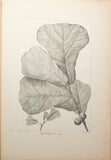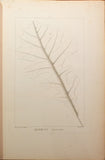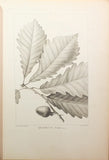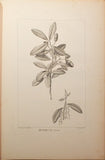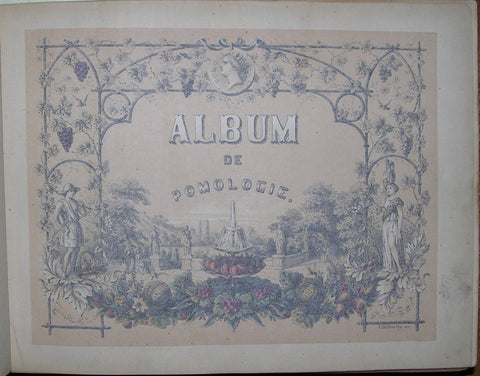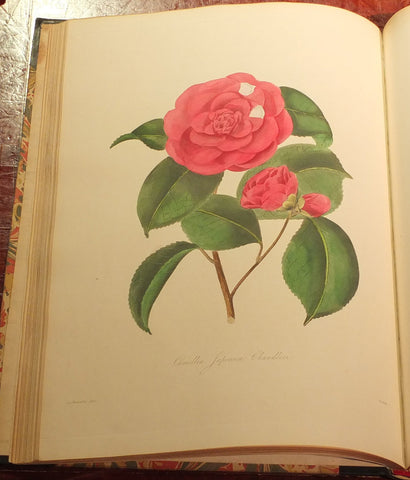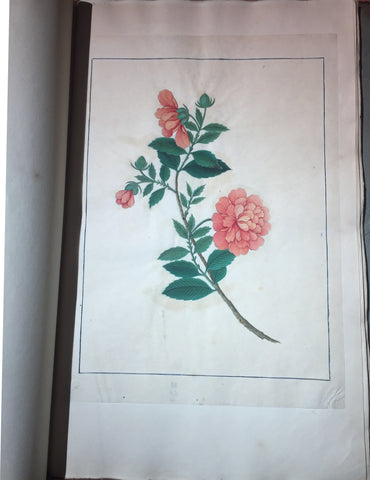Andre Michaux (1746-1802) Pierre-Joseph Redouté (1759-1840), Histoire des Chênes de l'Amérique...
Andre Michaux (1746-1802) Pierre-Joseph Redouté (1759-1840)
Histoire des Chênes de l'Amérique...
Paris: l'Imprimerie de Crapelet, 1801.
Folio (17 x 11 ¾ inches). Half-title. 36 fine engraved plates (marginal staining throughout, not affecting images). Contemporary full mottled calf, gilt fillets, the smooth spine in 6 gilt-ruled compartments (darkened by smoke, front hinge cracked).
First edition. With 32 plates after Pierre-Joseph Redouté, the remainder by his brother Henri-Joseph Redouté (1766-1852). Michaux was a French botanist and explorer best known for his study of North American flora. The present volume, a study of North American oaks, represents “the results of Michaux’s ten year sojourn in North America under the commission from the French government. His interest in North American trees was also to assess their importance as timber for the construction of naval vessels” (A Catalogue of Rédoutéana, 8). Michaux’s “contribution to our knowledge of American plant life made for him a place of imperishable distinction as an American botanist” (Humphry, Makers of North American Botany, p. 177).
Upon the death of his wife in 1770, Michaux was plunged into a deep depression. “The naturalist Louis-Guillaume Le Monnier (1717-1799) recommended a sustained study how foreign plants could be grown in France as a way to occupy the heartbroken Michaux. Michaux followed the advice. He conducted experiments on his farm and later became a student of the French naturalist Bernard de Jussieu (1699-1777) at Trianon.
“Michaux subsequently studied at the Jardin du Roi, now known as Jardin des Plantes in Paris. During this period, he made the acquaintance of many eminent scientists of the day, including the Garden’s long-time director Georges-Louis Leclerc, Comte du Buffon (1707-1788, APS 1768), whose assertion of American degeneracy provoked an extensive rebuttal by Thomas Jefferson in his Notes. Michaux also met the Garden’s superintendent André Thouin (1746-1824), a friend and correspondent of Jefferson.
“During his tenure at the Jardin du Roi, Michaux conducted extensive botanizing expedition throughout England, France and Spain. In 1782 he embarked on what would be a three-year journey through the Middle East to collect seeds and plants. His subsequent plan to explore the regions of Kashmir and Tibet was thwarted when the French government instead chose him to lead a scientific mission to the United States. The primary goal of the expedition was to search for plants that could be used in France, including new species of trees with which to replenish French forests. Prior to the journey Michaux was appointed King’s Botanist.
“In 1785 Michaux departed for North America with a gardener and his fifteen-year old son François André. Michaux founded a nursery at Hackensack, New Jersey, and the next year established a base in Charleston, South Carolina, from which he launched expeditions through various parts of Canada and the United States, from Nova Scotia to Spanish Florida, into the Ohio River Valley, Kentucky, and the prairies of Illinois. While his main objective was the collection of plants, he also introduced several plants into North America, including the mimosa or silk tree, the crape myrtle, the tea plant, and the camellia. Michaux kept journals in which he recorded in great detail the conditions of travel, the day’s progress, and the plants he observed.
“Michaux made contact with many leading Americans, including several prominent members of the American Philosophical Society. He met, for example, Benjamin Franklin, George Washington (1731-1799, APS 1780), John Bartram (1699-1777, APS 1768), and Thomas Jefferson (1743-1826, APS 1780). In 1792, Jefferson enlisted the Society to sponsor Michaux to "find the shortest & most convenient route of communication between the U.S. & the Pacific Ocean." However, political complications prematurely ended the mission when Jefferson learned that Michaux apparently intended to aid the French Foreign Minister Edmond-Charles Genet (1763-1834) in his efforts to arouse support for France. The nature of the secret political mission that Michaux supposedly agreed to undertake is still largely unclear; in any event, the controversy left Michaux without support to complete the expedition.
Despite these difficulties and France’s diminishing ability to finance his work, Michaux continued with his botanical studies and travels in the United States for three more years. He was not only an astute observer of plants but he also was particularly skilled in questioning local people about their produce and agricultural practices. Indeed, a contemporary noted that Michaux “was not a Frenchman, an Englishman, or a Canadian, but everywhere one found him closer to the natives than any other foreigner would have been.”
In 1796 Michaux embarked from North America for France. Four weeks after his departure, his ship was wrecked off the coast of Holland. His herbarium was damaged, and he lost some of his manuscripts, but he arrived safely in Paris in December 1796. To his disappointment, he learned that most of the thousands of trees he had sent from North America had not survived the turmoil of the revolution. Furthermore, he was unable to secure funding that would have allowed him to return to the United States, as he had hoped.
Instead, for the next four years, Michaux focused on the cultivation of his collected plants and on preparing for publication his studies Oaks of North America (1801) and Flora of North America (1803). Finally, in 1800 Michaux set out for another expedition, this time to Australia. In 1801 he left ship at the island of Mauritius to study plant life there. In 1802 he went on to Madagascar where he died of a fever” (American Philosophical Society online). Great Flower Books p. 67. Nissen BBI 1358. Hunt, Redoutéana 8. Stafleu & Cowan 5957. Sabin 48692. Pritzel 6194.
We Also Recommend


